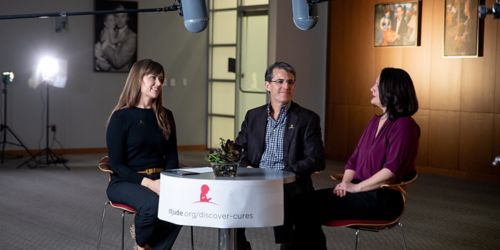St. Jude Family of Websites
Explore our cutting edge research, world-class patient care, career opportunities and more.
St. Jude Children's Research Hospital Home

- Fundraising
St. Jude Family of Websites
Explore our cutting edge research, world-class patient care, career opportunities and more.
St. Jude Children's Research Hospital Home

- Fundraising
Resources, collaboration: two components of great research

St. Jude makes an extraordinary commitment to helping ensure our research teams have the resources to devote maximum time to their research.
Just about everyone who works at St. Jude has a story about being stopped outside of work. Someone sees you wearing a St. Jude shirt or notices the logo on your tote bag and wants to tell you how much the place has meant to them. It’s happened to me numerous times. In fact, recently I was at dinner with my son and a woman came up and asked, "Do you work at St. Jude?" It caught me by surprise because I wasn’t wearing St. Jude clothing, until I realized I still had my ID badge on. And so, I said yes, and she told me her story.
Imagine complete strangers wanting to tell you how much they love the place you work.
I love it, too. For the mission, of course, but also for the extraordinary commitment St. Jude makes to all the resources that go into finding cures. Danny Thomas took on the biggest challenge imaginable, created something out of nothing here because he saw a need, and because of that, innovation is in this place’s DNA. I know, because as Operations Director, it’s my job to coordinate — and sometimes invent — the resources necessary to facilitate research and lab work. My own job, actually, was created after I moved here to work as a research technician. It became increasingly evident that we needed a point of contact within the department to look at facilities, buy new pieces of equipment, and assign point persons for common equipment and working with the labs. I did it part time for a while, until the department chair realized it should be a full-time position.
That evolution has led to our building seven cores within our department so researchers can devote maximum time to their area of expertise. Researchers need to have that first pilot experiment or piece of a puzzle, but they don’t necessarily need to be involved with every aspect of the process. By having these cores, these small hubs of innovation within the department, the research can move a lot faster. This is unique to St. Jude and has allowed us to recruit the very best scientists across a range of core interests.
And one thing you hear over and over again from these researchers is how, at other labs, they felt siloed, or worked in an environment where labs didn’t talk to one another. The word they always use to describe St. Jude is “collaborative.” This is a collegial environment constantly seeking better ways to use and share our phenomenal resources, and the research is better because of it.
Here’s just the latest example: Our department identified a need to be able to probe the inner workings of neurons and cancer cells in a way that currently isn’t possible. So, we’re literally building a new microscope from the ground up. And I can tell you that because I've had to buy every nut, bolt, screw, and laser to go with it.
But that’s just the attitude we have — everyone, not just the scientists and investigators and the faculty members, but the people cleaning the floors at night and the electricians and the repair people — to do whatever it takes.
If that sounds like a great culture to you (and trust me, it is), think about what working here could mean for you. Our hands-on training is legendary for those just getting into research and lab work. The postdoctoral fellows in our department have gone on to tenure-track faculty appointments at a rate three times the national average. Others have gone on to lead core facilities or publish their own research journals. Science is increasingly multidisciplinary, so we love recruiting people with a breadth of experiences.
And of course, it all comes back to the mission — finding cures that have an extraordinary impact at a worldwide level, but also on a deeply personal level, changing lives of patients in ways that wouldn’t have been thought possible before St. Jude was created. Patients and family members will remind you of that every single day.
To explore careers at St. Jude, visit stjude.org/discover-cures.






